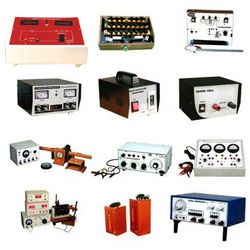ELECTRONIC INSTRUMENTS Questions :-
1. An ammeter is connected in …………….. with the circuit element whose current we wish to measure
- Series
- Parallel
- Series or parallel
- None of the above
Answer: 1
2. A galvanometer in series with a high resistance is called ……………
- An ammeter
- A voltmeter
- A wattmeter
- None of the above
Answer: 2
3. An ammeter should have ………….. resistance
- Infinite
- Very large
- Very low
- None of the above
Answer: 3
4. A voltmeter is connected in a ………….. with the circuit component across which potential difference is to be measured
- Parallel
- Series
- Series or parallel
- None of the above
Answer: 1
5. A voltmeter should have ………. resistance
- Zero
- Very high
- Very low
- None of the above
Answer: 2

6. The sensitivity of a multimeter is given in ……………..
- O
- Amperes
- kO/V
- none of the above
Answer: 3
7. If the full-scale deflection current of a multimeter is 50 µA, its sensitivity is ……..
- 10 kO/V
- 100 kO/V
- 50 kO/V
- 20 kO/V
Answer: 4
8. If a multimeter has a sensitivity of 1000 O per volt and reads 50 V full scale, its internal resistance is ………..
- 20 kO
- 50 kO
- 10 kO
- None of the above
Answer: 2
9. A VTVM has ………. input resistance than that of a multimeter
- More
- Less
- Same
- None of the above
Answer: 1
10. The input resistance of a VTVM is about ………..
- 1000 O
- 10 kO
- 20 kO
- 10 MO
Answer: 4
11. If the negative potential on the control grid of CRT is increased, the intensity of spot ………….
- Is increased
- Is decreased
- Remains the same
- None of the above
Answer: 2
12. For display of signal pattern ………… voltage is applied to the horizontal plates of a CRO
- Sinusoidal
- Rectangular
- Sawtooth
- None of the above
Answer: 3
13. Two multimeters A and B have sensitivities of 10 kO/V and 30 kO/V respectively. Then …………..
- Multimeter A is more sensitive
- Multimeter B is more sensitive
- Both are equally sensitive
- None of the above
Answer: 2
14. A galvanometer of resistance G is shunted by a very small resistance S. The resistance of the resulting ammeter is ………………
- GS/(G+S)
- G+S
- G-S
- None of the above
Answer: 1
15. A VTVM is never used to measure …………..
- Voltage
- Current
- Resistance
- None of the above
Answer: 2
16. The sensitivity of a voltmeter which uses a 100 µA meter movement is ……………..
- 1 kO/V
- 10 kO/V
- 5 kO/V
- Data insufficient
Answer: 2
17. What is the total resistance of a voltmeter on the 10 V range when the meter movement is rated for 50 µA of full-scale current?
- 10 kO
- 20 kO
- 200 kO
- None of the above
Answer: 3
18. The materil used to coat inside the face of CRT is …………..
- Carbon
- Sulphur
- Silicon
- Phosphorous
Answer: 4
19. When an ammeter is inserted in the circuit, the circuit current will ………..
- Increase
- Decrease
- Remain the same
- None of the above
Answer: 2
20. A series ohmmeter circuit uses a 3 V battery and a 1 mA meter movement. What is the half-scale resistance for this movement?
- 3 kO
- kO
- kO
- 6 kO
Answer: 1
21. The most accurate device for measuring voltage is ………….
- Voltmeter
- Multimeter
- CRO
- VTVM
Answer: 3
22. The horizontal plates of a CRO are supplied with …………. to observe the waveform of signal.
- Sinusoidal wave
- Cosine wave
- Sawtooth wave
- None of the above
Answer: 3
23. A CRO is used to measure ………….
- Voltage
- Frequency
- Phase
- All of above
Answer: 4
24. If 2% of the main current is to be passed through a galvanometer of resistance G, then resistance of the shunt required is ……….
- G/50
- G/49
- 49 G
- 50 G
Answer: 2
25. Which of the following is likely to have the largest resistance?
- Voltmeter of range 10 V
- Moving coil galvanometer
- Ammeter of range 1 A
- A copper wire of length 1 m and diameter 3 mm
Answer: 1
26. An ideal ammeter has ………… resistance
- Low
- Infinite
- Zero
- High
Answer: 3
27. The resistance of an ideal voltmeter is …………
- Low
- Infinite
- Zero
- High
Answer: 2
28. To send 10% of the main current through a moving coil galvanometer of resistance 99 O the shunt required is …………..
- 11 O
- 9 O
- 100 O
- 9 O
Answer: 1
29. A voltmeter has a resistance of G ohms and range V volts. The value of resistance required in series to convert it into voltmeter of range nV is ……………
- nG
- G/n
- G/(n-1)
- (n-1)G
Answer: 4
30. An ammeter has a resistance of G ohms and range of I amperes. The value of resistance required in parallel to convert it into an ammeter of range nI is ………….
- nG
- (n-1)G
- G/(n-1)
- G/n
Answer: 3